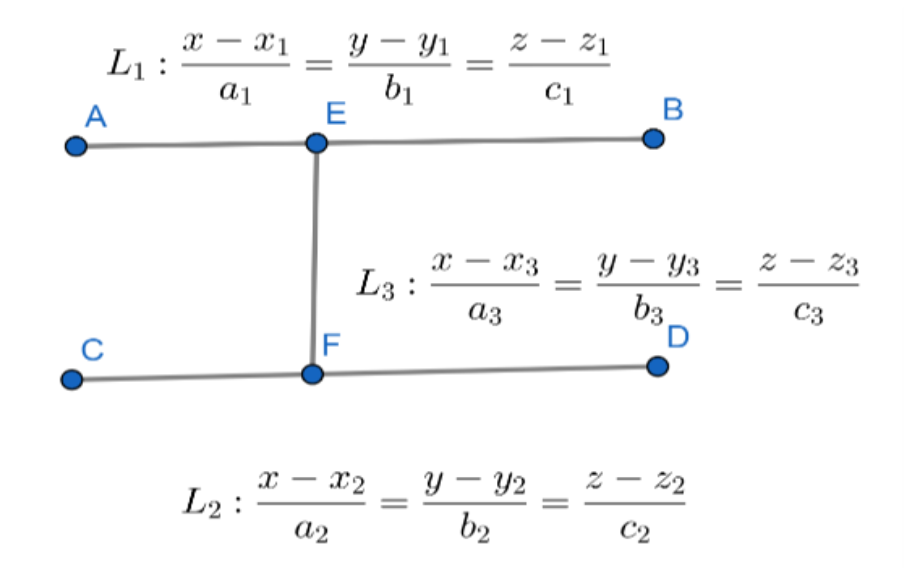Question
Question: The equation of the line of shortest distance between the lines \[\dfrac{x+4}{4}=\dfrac{y-2}{-2}=\df...
The equation of the line of shortest distance between the lines 4x+4=−2y−2=0z−3 and 5x−5=3y−3=0z, is
& (A)\text{ }\dfrac{x+4}{0}=\dfrac{y-2}{0}=\dfrac{z-3}{1} \\\ & (B)\text{ }\dfrac{x-5}{0}=\dfrac{y-3}{0}=\dfrac{z}{1} \\\ & (C)\text{ }\dfrac{x}{0}=\dfrac{y}{0}=\dfrac{z-3}{1} \\\ & (D)\text{ None of these} \\\ \end{aligned}$$Solution
We needed to remember that the line of shortest distance between lines L1:a1x−x1=b1y−y1=c1z−z1 and L2:a2x−x2=b2y−y2=c2z−z2 is L3:a3x−x3=b3y−y3=c3z−z3 which must be perpendicular and also passes through the both L1:a1x−x1=b1y−y1=c1z−z1 and L2:a2x−x2=b2y−y2=c2z−z2. By this point, we can solve the problem. Now we should equate L1:a1x−x1=b1y−y1=c1z−z1 to a constant λ. In the similar way, we should equate L2:a2x−x2=b2y−y2=c2z−z2 to a constant μ. Now we should find the line passing through these two points. Let us assume this line as L3:a3x−x3=b3y−y3=c3z−z3. This line should be perpendicular to both L1:a1x−x1=b1y−y1=c1z−z1 and L2:a2x−x2=b2y−y2=c2z−z2 This will give us the L3:a3x−x3=b3y−y3=c3z−z3. Now by using the concept of sum of product of directional ratios of perpendicular will be zero, we can find the values of both λ and μ.
Complete step-by-step solution:
From the given information, let us assume L1:4x+4=−2y−2=0z−3 and L2:5x−5=3y−3=0z.
Let L1:4x+4=−2y−2=0z−3=λ.....(1)
From the equation (1) we get
4x+4=λ
By using cross multiplication, we get
⇒x=4λ−4......(2)
In the same way, from equation (1) we get
−2y−2=λ
By using cross multiplication, we get
⇒y=−2λ+2......(3)
In the same way, from equation (3) we get
0z−3=λ
By using cross multiplication, we get
⇒z=3......(4)
From equation (2), (3) and (4) let us assume a point on L1:4x+4=−2y−2=0z−3is A(4λ−4,−2λ+2,3).
Let L2:5x−5=3y−3=0z=μ....(5)
From the equation (5) we get
5x−5=μ
By using cross multiplication, we get
⇒x=5μ+5.....(6)
In the same way, from equation (5) we get
3y−3=μ
By using cross multiplication, we get
⇒y=3μ+3.....(7)
In the same way, from equation (5) we get
0z=μ
By using cross multiplication, we get
⇒z=0......(8)
From equation (5), (6) and (7) let us assume a point on L2:5x−5=3y−3=0z=μ....(5) is B(5μ+5,3μ+3,0).
We know that the equation of line passing through A(x1,y1,z1) and B(x2,y2,z2) is x2−x1x−x1=y2−y1y−y1=z2−z1z−z1
Now we can find the equation of line passing through A(4λ−4,−2λ+2,3) and B(5μ+5,3μ+3,0) is L3:(5μ+5)−(4λ−4)x−(4λ−4)=(3μ+3)−(−2λ+2)y−(−2λ+2)=0−3z−3
⇒L3:(5μ−4λ+9)x−4λ+4=(2λ+3μ+1)y+2λ−2=−3z−3
We know that the line of shortest distance between lines L1:a1x−x1=b1y−y1=c1z−z1 and L2:a2x−x2=b2y−y2=c2z−z2 is L3:a3x−x3=b3y−y3=c3z−z3which must be perpendicular to both }L1:a1x−x1=b1y−y1=c1z−z1 and L2:a2x−x2=b2y−y2=c2z−z2.

From the above condition, we get
L3:(5μ−4λ+9)x−4λ+4=(2λ+3μ+1)y+2λ−2=−3z−3is perpendicular to both L1:4x+4=−2y−2=0z−3 and L2:5x−5=3y−3=0z
We know that a line L1:a1x−x1=b1y−y1=c1z−z1 is said to be perpendicular to L2:a2x−x2=b2y−y2=c2z−z2 , if a1a2+b1b2+c1c2=0.
So, LineL3:(5μ−4λ+9)x−4λ+4=(2λ+3μ+1)y+2λ−2=−3z−3 should be perpendicular to L1:4x+4=−2y−2=0z−3.
We get a1=5μ−4λ+9,b1=(2λ+3μ+1),c1=−3 and a2=4,b2=−2,c2=0.
a1a2+b1b2+c1c2=0
⇒4(5μ−4λ+9)+(−2)(2λ+3μ+1)+3(0)=0
⇒20μ−16λ+36−4λ−6μ−2=0
⇒−20λ+14μ+34=0
⇒20λ−14μ−34=0
⇒10λ−7μ−17=0.....(9)
In the similar manner, we know that lineL3:(5μ−4λ+9)x−4λ+4=(2λ+3μ+1)y+2λ−2=−3z−3 should be perpendicular to L2:5x−5=3y−3=0z.
We get a1=5μ−4λ+9,b1=(2λ+3μ+1),c1=−3 and a2=5,b2=3,c2=0.
a1a2+b1b2+c1c2=0
⇒5(5μ−4λ+9)+(3)(2λ+3μ+1)+3(0)=0
⇒25μ−20λ+45+6λ+9μ+3=0
⇒−14λ+34μ+48=0
⇒14λ−34μ−48=0
⇒7λ−17μ−24=0.....(10)
We need to find the values of λ and μ, to get the equation of line L3:(5μ−4λ+9)x−4λ+4=(2λ+3μ+1)y+2λ−2=−3z−3.
By solving equations (9) and (10) we will get the values of λ and μ.
We should multiply equation (9) by 7.
70λ−49μ−119=0....(11)
We should multiply (10) by 10.
70λ−170μ−240=0.....(12)
Now we should subtract (11) and (12).
